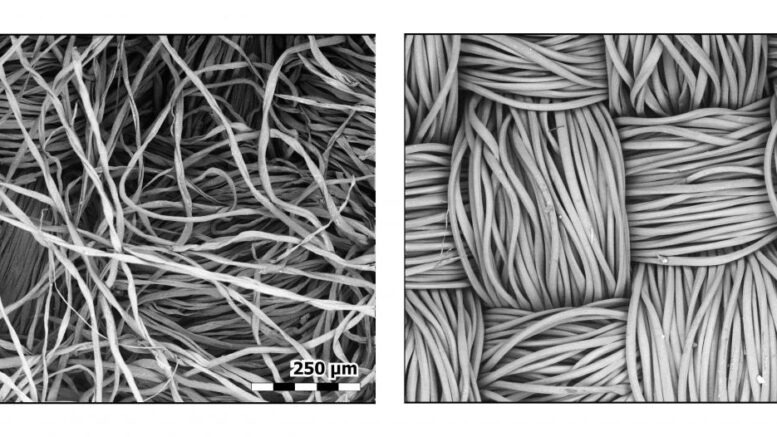Scanning electron microscope images of cotton flannel (left) and polyester (right). Cotton fibers absorb moisture from breath, which increases filtration. Each segment of the image scale bars is 50 micrometers, or millionths of a meter -- roughly the width of a human hair. Courtesy of E.P. Vicenzi/Smithsonian's Museum Conservation Institute and NIST
Researchers have come up with a better way to test which fabrics work best for masks that are meant to slow the spread of COVID-19. By testing those fabrics under conditions that mimic the humidity of a person's breath, the researchers have obtained measurements that more accurately reflect how the fabrics perform when worn by a living, breathing person.
The new measurements show that under humid conditions, the filtration efficiency -- a measure of how well a material captures particles -- increased by an average of 33% in cotton fabrics. Synthetic fabrics performed poorly relative to cotton, and their performance did not improve with humidity. The material from medical-procedure masks also did not improve with humidity, though it performed in roughly the same range as cottons.
This study, conducted by scientists at the National Institute of Standards and Technology (NIST) and the Smithsonian's Museum Conservation Institute, was published in ACS Applied Nano Materials.
An earlier study by the same research team showed that dual-layer masks made of tightly woven cotton fabrics with a raised nap, such as flannels, are particularly effective at filtering breath. That study was conducted under relatively dry conditions in the lab, and its main finding still stands.
"Cotton fabrics are still a great choice," said NIST research scientist Christopher Zangmeister. "But this new study shows that cotton fabrics actually perform better in masks than we thought."
The researchers also tested whether humidity makes the fabrics harder to breathe through and found no change in breathability.
The Centers for Disease Control and Prevention (CDC) recommends that people wear masks to slow the spread of COVID-19. When worn correctly, those masks filter out some of the virus-filled droplets that an infected person exhales and also offer some protection to the wearer by filtering incoming air.
This study is one of several, conducted by NIST and other organizations, that contributed to the first standards for fabric masks meant to slow the spread of COVID-19. Those standards were recently released by the standards-developing organization ASTM International.
The filtration efficiency of cotton fabrics increases in humid conditions because cotton is hydrophilic, meaning it likes water. By absorbing small amounts of the water in a person's breath, cotton fibers create a moist environment inside the fabric. As microscopic particles pass through, they absorb some of this moisture and grow larger, which makes them more likely to get trapped.
Most synthetic fabrics, on the other hand, are hydrophobic, meaning they dislike water. These fabrics do not absorb moisture, and their filtration efficiency does not change in humid conditions.
For this study, the team tested fabric swatches, not actual masks. First, they prepared dual-layer fabric swatches by placing them inside a small box where the air was maintained at 99% humidity -- roughly the same as a person's exhaled breath. For comparison, a second set of swatches were prepared at 55% humidity. After the fabrics reached an equilibrium with the humidified air, the researchers placed them in front of a pipe that emitted air at about the same velocity as exhaled breath. That air carried salt particles in a range of sizes typical of the droplets that a person exhales when breathing, speaking and coughing. This salt particle method is recommended by the CDC's National Institute for Occupational Safety and Health (NIOSH) for measuring the filtration performance of mask-making materials.
The researchers calculated filtration efficiency by measuring the number of particles in the air before and after it passed through the fabric. They measured breathability by measuring the air pressure on both sides of the fabric as the air passed through it.
The researchers tested nine different types of cotton flannel, which under humid conditions increased their filtration efficiencies from 12% to 45%, with an average increase of 33%. They tested six types of synthetic fabric, including nylon, polyester and rayon. All performed poorly in comparison to cotton flannel regardless of humidity. Medical-procedure masks and N95 respirator masks provided the same filtration efficiency under both high and low humidity conditions.
While the change in performance for cotton flannels is large, they don't actually absorb very much water. Under humid conditions, a two-layer cotton flannel mask absorbs about 150 milligrams of water from human breath, the equivalent of just one or two drops. If fabric masks actually get wet in other ways, they may become difficult to breathe through, and the CDC advises that people not wear them for activities such as swimming. If masks become wet due to weather, they should be changed.
While this research provides useful information for people who wear face masks, it also holds lessons for scientists who are working to improve masks and measure their performance.
"To understand how these materials perform in the real world," Zangmeister said, "we need to study them under realistic conditions."
Reference: : C.D. Zangmeister, J.G. Radney, M.E. Staymates, E.P. Vicenzi and J.L. Weaver. Hydration of Hydrophilic Cloth Facial Coverings Greatly Increases the Filtration Properties for Nanometer and Micron-sized Particles. ACS Applied Nano Materials. March 8, 2021. DOI: 10.1021/acsanm.0c03319
Source: National Institute of Standards and Technology (NIST)

Be the first to comment on "Humidity in Breath Makes Cotton Masks More Effective at Slowing the Spread of COVID-19"